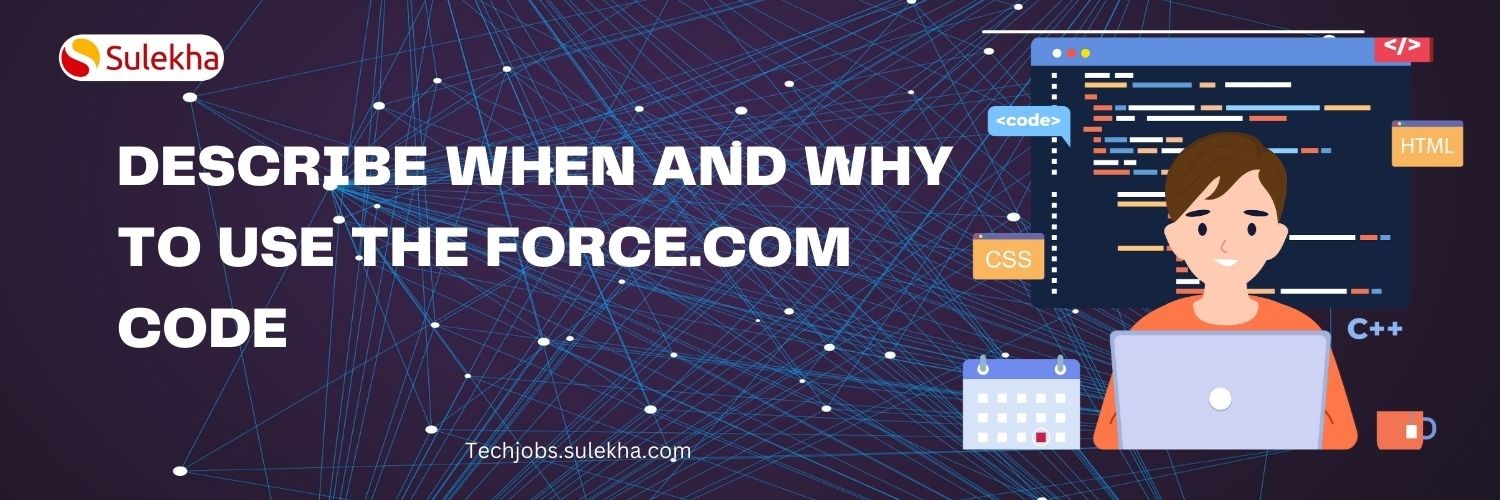Wrapper Class in Salesforce
In our previous blogs (Introduction to Force.com Sites – Overview), we discussed various crucial concepts of Force.com and about Force.com and its features. Now, we shall learn 'What is wrapper class in Salesforce?' in detail. To learn more features and crucial concepts of Salesforce, you can join Salesforce certification course.
In Salesforce, a wrapper class is a custom Apex class defined by a developer to contain different data types, such as primitives, objects, or collections, within a single object. The primary purpose of a wrapper class is to bundle and organize disparate pieces of data into a single unit, making it easier to handle and pass around in Apex code, especially when working with Visualforce pages or Lightning components.
Wrapper classes are often used when you need to display or manipulate data in a way not directly supported by standard Salesforce functionality. For example, when you want to present a combination of fields from multiple objects in a Visualforce page or Lightning component, you can use a wrapper class to structure the data more meaningfully.
An exemplifying example entails using a wrapper class to retrieve and display account records by presenting them in an in-page block table. The user is provided with a checkbox functionality that enables linking several serial numbers to retrieve and show the equivalent quantity of records. At the same time, there may be more than one record with a matching serial number.
When examining the structure of Salesforce, it has similarities to a database system, wherein the data is organized into rows representing records, columns representing fields, and tables representing objects. Salesforce is equipped with the Model-View-Controller (MVC) architecture, which encompasses several sets of classes allocated to assist the development process effectively.
Wrapper Class in Salesforce as a Solution
Wrapper class in Salesforce is a powerful solution that allows developers to combine different data types into a single object, making it easier to work with and manipulate data in Apex code. This class is a container for multiple data types, such as custom objects, standard objects, and primitive data types. It provides a way to access and manipulate these data types within a single object.
One of the main benefits of using a wrapper class in Salesforce is that it simplifies working with complex data structures. Instead of managing multiple objects and data types separately, developers can use a wrapper class to encapsulate all the necessary data in a single object, making it easier to pass and manipulate data within the code.
Wrapper classes also provide a way to customize the display and behavior of data in Salesforce user interfaces. Using a wrapper class, developers can define custom logic and formatting for how data is displayed and interacted with in Salesforce. This provides a more intuitive and user-friendly experience for end users.
In addition, wrapper classes can simplify the process of passing data between different components of a Salesforce application. For example, a wrapper class can encapsulate data from a custom object and pass it to a Visualforce page, making it easier to work with and display the data in the user interface.
Wrapper Class Use Case in LWC
· Present the list of open cases as a DataTable.
· Make sure the user has the option to select more than one scenario at once.
· Create a "Close Selected Cases" button.
· All selected cases should be closed when you click the "Close Selected Cases" button.
Advantages of a Wrapper Class in Salesforce
1. Data Encapsulation: Wrapper classes encapsulate the data and provide a layer of abstraction, making it easier to manage and manipulate complex data structures.
2. Customization: Wrapper classes allow developers to customize how data is presented and manipulated, providing a more user-friendly experience for end users.
3. Improved Performance: By encapsulating data and providing custom methods for manipulation, wrapper classes can improve the performance of data processing and retrieval.
4. Reusability: Wrapper classes can be reused across different components and applications, reducing the need to rewrite code and improving overall development efficiency.
5. Enhanced Security: Wrapper classes can provide an additional layer of security by controlling access to data and ensuring that only authorized users can manipulate it.
6. Integration with External Systems: Wrapper classes can integrate Salesforce data with external systems, providing a standardized way to communicate and exchange data.
7. Simplified Maintenance: By encapsulating data and providing a clear interface for manipulation, wrapper classes can simplify maintenance and reduce the likelihood of errors in the codebase.
Wrapper Class as an Everyday Tool in Salesforce
Wrapper class is an essential tool in Salesforce that allows developers to group different data types into a single object. This makes it easier to work with complex data structures and pass them between various components of a Salesforce application.
One of the most common use cases for wrapper classes in Salesforce is in Visualforce pages and Lightning components. These classes can represent complex data structures, such as a list of related records, and make it easier to display and manipulate this data in the user interface.
For example, suppose you have a Visualforce page with a list of opportunities and their related contacts. In that case, you can use a wrapper class to group the opportunity and
contact data into a single object. This makes it easier to iterate through the list of opportunities and access the related contact information for each opportunity.
Wrapper classes can also be used to simplify the process of passing data between different components of a Salesforce application. For example, suppose you have a Lightning component that needs to retrieve data from a server-side controller and display it in the user interface. In that case, you can use a wrapper class to encapsulate the data and pass it between the client and server-side components.
A few activities included are as follows:
· Using a mapping table to connect numbers for different fields of an object at the same time
· Combining different threads of data into a single list
· Adding to a data object by taking data from another item
So, for all of these crises, wrapper classes are the best solution because every wrapper class has a distinct specification design based on the user requirement. Due to this, wrapper classes are more suitable and reliable.
It's not possible to set the usual inner class in the wrapper class, but having an inner class can make things easier and faster in Salesforce. A wrapper class is used for any other class in the same way that unions, structures, or algebraic types are used for other classes. The method can only go so far and may be dynamic in Apex.
To effectively create a robust wrapper class, utilizing well-designed properties within the class is essential instead of relying on intricate rendering techniques. Additionally, it is necessary to consider the significant need for human enforcement of support. Therefore, data reorganization may entail certain obligations to ensure all rights are correctly enforced.
MVC Architecture
MVC (Model-View-Controller) architecture in Salesforce is a design pattern that separates an application into three interconnected components: the model, the view, and the controller.
The model represents the data and business logic of the application, the view is responsible for displaying the user interface, and the controller acts as an intermediary, handling user input and updating the model and view accordingly. This separation of concerns makes the application more modular and easier to maintain and allows for better collaboration among developers working on different application components.
In Salesforce, the MVC architecture is implemented through features like custom objects and fields (model), Visualforce pages and Lightning components (view), and Apex controllers (controller).
Three modules of MVC architecture
1. Model: This module represents the data and business logic of the application. It is responsible for managing the data and the rules for accessing and manipulating it.
2. View: This module represents the user interface of the application. It is responsible for displaying the data and capturing user input.
3. Controller: This module is an intermediary between the Model and View. It is responsible for processing user input, updating the Model, and updating the View accordingly. It also contains the application logic for handling user requests and coordinating the interactions between the Model and View.
Developers are constrained to utilizing a specific data structure corresponding to a particular object type. However, the interconnection between different data structures is crucial. To collectively manage several objects, utilizing a single object for each field is sufficient. This condition may first induce confusion. However, with enough experience, one can overcome this challenge.
There exist two distinct categories of controllers: standard controllers and custom controllers. In Salesforce, controllers are responsible for modeling and observing pages, components, and objects.
If you google image of controllers, you can understand that a singular contact can possess several orders, each containing a diverse range of order lines. An example of this type of layered structure is seen in a NoSQL or JSON database.
Conclusion
Using a wrapper class has been empirically demonstrated that it enables professional development of Salesforce Developers by offering a broader array of options and expanded features. This technology is utilized across the board, and Salesforce Developers have also recognized its advantages.
So, whenever you intend to compare a custom object or wish to add any additional functionality, you can utilize wrapper classes. Moreover, you can also add fields within the object when it is necessary and also can increase the usability of an application.
Find a course provider to learn Salesforce
Java training | J2EE training | J2EE Jboss training | Apache JMeter trainingTake the next step towards your professional goals in Salesforce
Don't hesitate to talk with our course advisor right now
Receive a call
Contact NowMake a call
+1-732-338-7323Take our FREE Skill Assessment Test to discover your strengths and earn a certificate upon completion.
Enroll for the next batch
Salesforce Course Online Training Course
- Sep 1 2025
- Online
Salesforce
- Sep 2 2025
- Online
Salesforce Course Online Training Course
- Sep 3 2025
- Online
Salesforce
- Sep 4 2025
- Online
Salesforce Course Online Training Course
- Sep 5 2025
- Online
Related blogs on Salesforce to learn more

INTRODUCTION TO CLINICAL RESEARCH
Learn the fundamentals of clinical trials, and eight phases of the clinical research process.

Describe when and why to use the Force.com code
Discover how to leverage the power of Apex code to automate business processes, enhance user experience, and improve data quality in your Salesforce organization.

Features of Force.com code and distinguish between Force.com code and other programming languages.
Learn how to seamlessly integrate Force.com pages into your Salesforce applications to enhance user experience and discover the steps to create, customize, and deploy custom pages that meet your specific business needs.

List and Describe Syntax Features of Force.com Code
Master the syntax features of Force.com code and description for each feature.
An Introduction: Integrating with the Salesforce Force.com Platform
Unlock the full potential of your Salesforce implementation by integrating it with external systems and applications.

Describe How to Incorporate Force.com Pages into Force.com Applications
Learn how to seamlessly integrate Force.com pages into your Salesforce applications to enhance user experience and discover the steps to create, customize, and deploy custom pages that meet your specific business needs.

Describe the save execution order and use of before and after triggers
Learn how to write triggers that execute at the right time to meet your specific business needs

Debugging, Testing, and Monitoring in Force.com: A Comprehensive Guide
Explore the essential techniques for debugging, testing, and monitoring your Force.com applications.
A Comprehensive Guide to Managing Static Resources in Salesforce
We have discussed the types of Static Resources, how to Create & Use Static Resources and best Practices for Managing Static Resources in Salesforce
Introduction to Force.com Sites – Overview
Learn about the features, benefits, and use cases for Force.com Sites, and discover how to create a custom website that integrates with your Salesforce data and workflows.
Latest blogs on technology to explore

Understanding Artificial Intelligence: Hype, Reality, and the Road Ahead
Explore the reality of Artificial Intelligence (AI) — its impact, how it works, and its potential risks. Understand AI's benefits, challenges, and how to navigate its role in shaping industries and everyday life with expert training programs

How Much Do Healthcare Administrators Make?
Discover how much healthcare administrators make, the importance of healthcare, career opportunities, and potential job roles. Learn about salary ranges, career growth, and training programs with Sulekha to kickstart your healthcare administration jo

How to Gain the High-Income Skills Employers Are Looking For?
Discover top high-income skills like software development, data analysis, AI, and project management that employers seek. Learn key skills and growth opportunities to boost your career.

What Companies Expect from Product Managers in 2025: Skills, Tools, and Trends
Explore what companies expect from Product Managers in 2025, including essential skills, tools, certifications, and salary trends. Learn how to stay ahead in a rapidly evolving, tech-driven product management landscape.

Breaking Into AI Engineering: Skills, Salaries, and Demand in the US
Discover how to break into AI engineering with insights on essential skills, salary expectations, and rising demand in the US. Learn about career paths, certifications, and how to succeed in one of tech’s fastest-growing fields.

Cybersecurity Training: Powering Digital Defense
Explore top cybersecurity training programs in the USA to meet rising demand in digital defense. Learn about certifications, salaries, and career opportunities in this high-growth field.

Why Pursue Data Science Training?
Empower your career in a data-driven world. Learn why data science training is crucial for high-demand jobs, informed decisions, and staying ahead with essential skills.

What Does a Cybersecurity Analyst Do? 2025
Discover the vital role of a Cybersecurity Analyst in 2025, protecting organizations from evolving cyber threats through monitoring, threat assessment, and incident response. Learn about career paths, key skills, certifications, and why now is the be

Artificial intelligence in healthcare: Medical and Diagnosis field
Artificial intelligence in healthcare: Medical and Diagnosis field

iOS 18.5 Is Here: 7 Reasons You Should Update Right Now
In this blog, we shall discuss Apple releases iOS 18.5 with new features and bug fixes